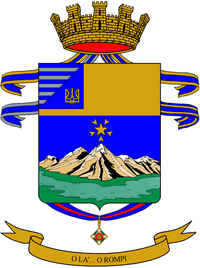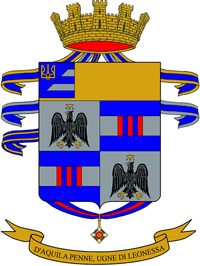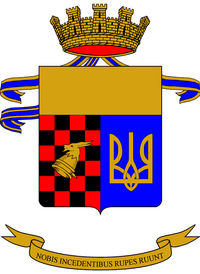3rd Alpine Division Julia
| 3a Divisione Alpina Julia | |
|---|---|
|
Coat of Arms of the 3rd Alpine Division Julia | |
| Active | December 10, 1935 – September 8, 1943 |
| Country | Italy |
| Branch | Regio Esercito |
| Type | Alpini |
| Role | Mountain Infantry |
| Size | 17,460 men |
| Part of |
Italian Alpine Corps 1942-1943 |
| Garrison/HQ | Udine |
| Engagements |
World War II Greco-Italian War Italian War in Soviet Union |
| ||||||
The 3rd Alpine Division Julia was a World War II light Infantry division of the Italian Army, specializing in Mountain Combat. The Alpini that formed the divisions are a highly decorated and elite mountain corps of the Italian Army comprising both infantry and artillery units. Today the traditions and name of the 3rd Alpine Division Julia are carried on by the Alpine Brigade Julia.
Order of battle
-
 8th Alpini Regiment
8th Alpini Regiment
-
 Gemona battalion
Gemona battalion -
 Tolmezzo battalion
Tolmezzo battalion -
 Cividale battalion
Cividale battalion
-
-
 9th Alpini Regiment
9th Alpini Regiment
-
 L'Aquila battalion
L'Aquila battalion -
 Vicenza battalion
Vicenza battalion -
 Bassano battalion (ceded to the 11th Alpini Regiment) on 25 September 1937
Bassano battalion (ceded to the 11th Alpini Regiment) on 25 September 1937
-
-
 3rd Alpine Artillery Regiment
3rd Alpine Artillery Regiment
- Conegliano artillery group
- Udine artillery group
- Val Piave' artillery group
-
 3rd Engineer Battalion
3rd Engineer Battalion - 207th Auto-Transport Battalion
- 415th, 416th Carabinieri Companies
- 628th, 629th, 633rd, 813th Field Hospitals
History
The division participated in the Greco-Italian War, where it suffered heavy casualties in the Battle of Pindus. The division was reformed and participated in the Axis invasion of the Soviet Union. Unlike the ordinary Italian infantry in Russia, the Alpini were better supplied when it came to rations, but they lacked winter coats.[1]The division fought well in Operation Little Saturn.[2]
- ↑ "The 15,000 men of the Ravenna Infantry Division received winter coats for less than 50 percent of their number, while the mountains troops of the Cuneense Division received only 3,000. Despite this, the Alpini tended to be better supplied than the infantry when it came to basics such as rations. A Cuneense officer, Veniero Marsan, arrived at the frontline and was despatched to liase with the neighbouring infantry battalion from the Cosseria. Invited to stay for lunch by his brother officers, he was horrified to be fed soup so thin that it resembled warm water with a few scraps of meat. He was too embarrassed to tell his hosts that when they had broth in their unit, it was so thick with meat and vegetables that a spoon would stand up on it." Death on the Don: The Destruction of Germany's Allies on the Eastern Front, 1941-1944, Jonathan Trigg, p. ?, The History Press, 2013
- ↑ " The Julia Division, which had come to Russia with 16,000 men and 4,000 mules, had fought very well and had never been overrun, and had gone home with 3,200 men and forty mules. The Tridentina had a surviving strength of 6,500 men, the Cuneense only 1,600, and the Vicenza which had been in the rear most of the time counted only 1,300 survivors." The Forgotten Axis: Germany's Partners and Foreign Volunteers in World War II, J. Lee Ready, p. 248, McFarland, 1987
